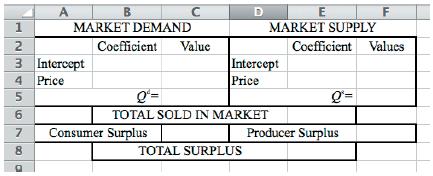2.2 We are going to use Excel to examine changes in the consumer and producer surpluses in...
Question:
2.2 We are going to use Excel to examine changes in the consumer and producer surpluses in a competitive market when the market is not in equilibrium. Consider the market for corn in the United States. Suppose the demand and supply functions for corn are as follows:
Qd = 100 - 14.5P Qs = 0 + 5.5P where Q is bushels of corn (in billions) and P is the market price per bushel.
Using the template provided, enter the coefficients for demand and supply, and set up your Qd and Qs to automatically calculate as you adjust the value for price. When the market is not at its equilibrium, the amount sold in the market will be the minimum of the quantity demanded and the quantity supplied. So to determine the quantity sold, use Excel’s MIN function, and set the cell reference to Qd and Qs.
Set up Excel to calculate consumer surplus
(CS), producer surplus (PS), and total surplus
(TS) for you using the following formulas:
CS = .5*(Demand Intercept - Price)*Total Sold in Market PS = .5*Price*Total Sold in Market TS = CS + PS

Once you have this set up, answer the following questions:
1. Start at a price of $3 per bushel, and increase the price in $0.50 increments until you reach market equilibrium. What are the equilibrium price and quantity?
2. What happens to the consumer, producer, and total surpluses as you increase the price from $3 to the equilibrium?
3. Now increase the price from the equilibrium by $0.25 two times. What happens to the market quantity and the consumer, producer, and total surpluses as you increase the price to a level higher than the equilibrium?
4. Do these results support the discussion in the text about overproduction, underproduction, and the efficient market quantity?
Explain why or why not.
Step by Step Answer:







